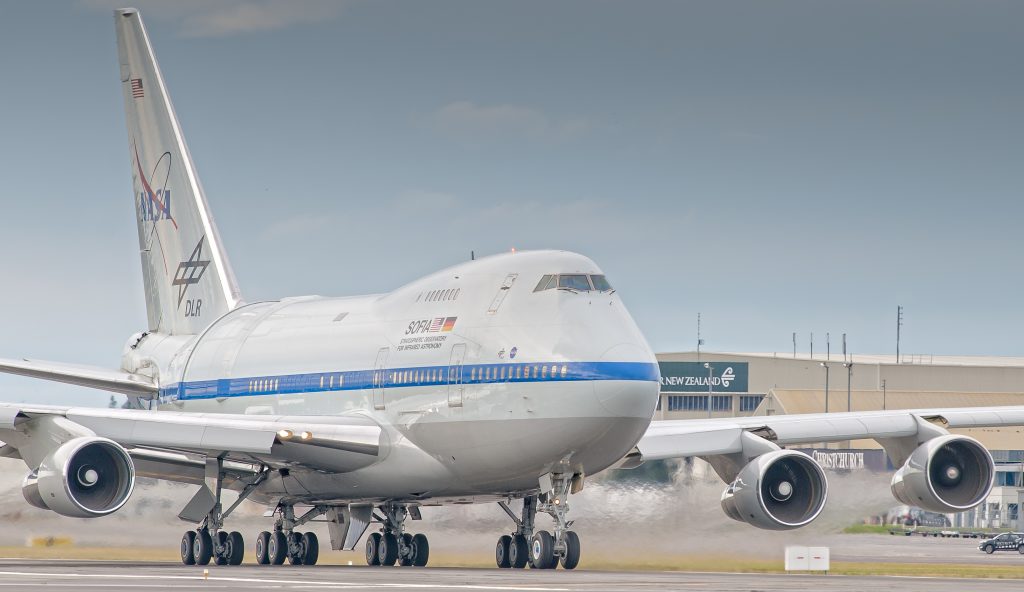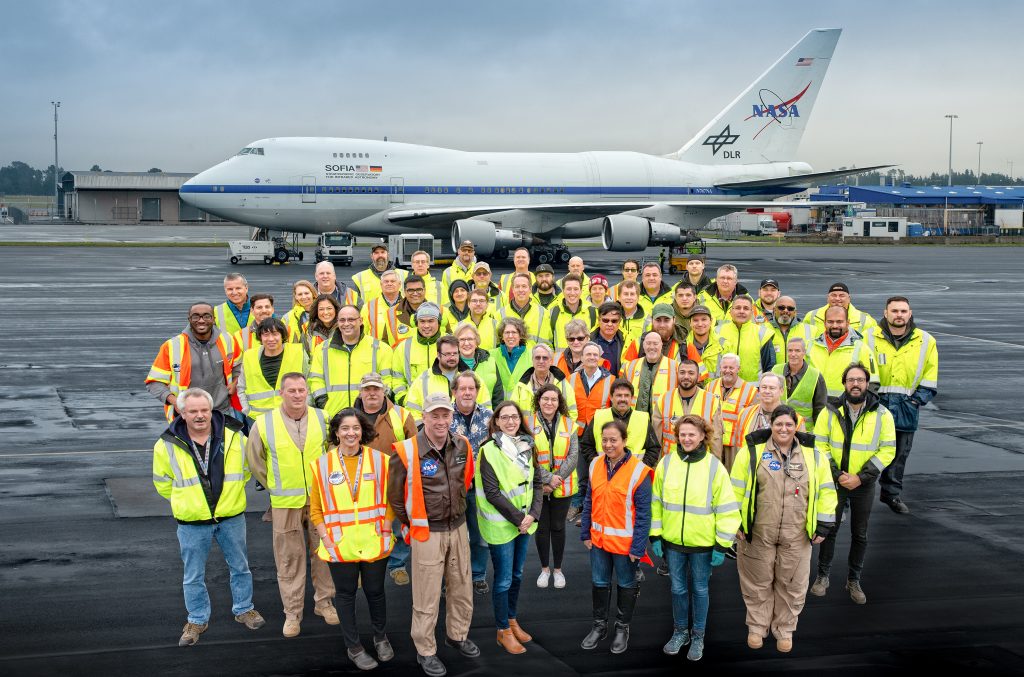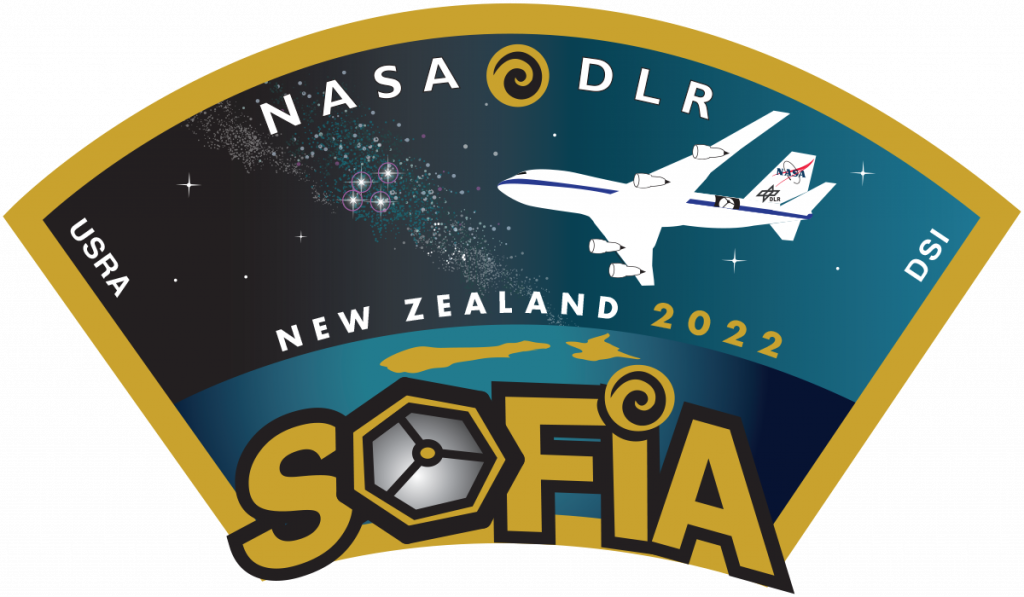By Maggie McAdam
After a two-year hiatus, SOFIA has returned to Christchurch, New Zealand, for a long deployment. About once a year, SOFIA temporarily moves its operating home to better observe celestial objects in the Southern Hemisphere.

There is always a high demand from the SOFIA scientific community to observe the southern skies, and SOFIA has been working to meet those needs. This year, we already deployed once to Santiago, Chile, for a quick, two-week deployment to observe the Large Magellanic Cloud. Now SOFIA is heading back to New Zealand for the seventh and final time.
“We are thrilled to be returning to Christchurch to continue to study and discover the infrared universe,” said Naseem Rangwala, the SOFIA project scientist.
SOFIA has made 12 deployments over its operational lifetime, generally leaving Palmdale, California, to observe celestial objects and phenomena not visible from its home skies. We observed occultations in Florida and New Zealand, as well as atomic oxygen in Earth’s atmosphere, stellar feedback, and magnetic fields from German soil.
Christchurch is often SOFIA’s home-away-from-home when deploying overseas. This time, SOFIA plans to conduct 32 flights to observe a wide range of celestial objects and phenomena, like cosmic magnetic fields, stellar feedback, and cosmic rays, using two instruments, HAWC+ and GREAT.
Probing the Magnetic Universe

Sticking relatively close to our cosmic home, SOFIA will start by investigating our galaxy, the Milky Way. A team of researchers is mapping the magnetic fields within the Milky Way’s central regions. These data will complement a previous Legacy Program that made mid-infrared images of the Milky Way. This work is similar to other cosmic magnetic field studies that map the shape and strength of this invisible force in other galaxies. SOFIA can detect cosmic magnetic fields on many scales, including star formation scales, especially along filaments.
SOFIA will also be looking at magnetic fields in filaments of material in our galaxy. These filaments are thread-like structures full of cold gas and dust. Most stars form in these dark rivers of material. A team of scientists will be investigating how magnetic fields play a role in star formation in filaments.
Stars Blowing Bubbles and a Barometer for Cosmic Rays

After HAWC+ finishes up probing the magnetic universe, SOFIA’s operations team will swap the instrument for the German PI-led GREAT instrument. GREAT does a wide variety of studies including looking at stellar feedback – how some stars can affect the regions around them. Young massive stars create huge winds that blow out into the surrounding dusty material, sometimes blowing celestial bubbles. As they do this, the stellar winds plow into the material and sometimes can trigger or quench star formation. Scientists want to understand when and why star formation is turned on or off.
GREAT, like the radio in your car, can be tuned to be sensitive to specific signals. During the New Zealand deployment, it will be set to register hydride molecules. These molecules were some of the first types that formed in our universe, and, even now, they are sometimes created in other environments. When scientists detect hydrides, they can use them as sensitive barometers for the presence of cosmic rays, high energy particles that travel close to the speed of light.
Hydride molecules form in very specific circumstances, and, usually, scientists can determine their production rate. At the same time, these molecules are quite delicate and can easily be destroyed by passing cosmic rays. Understanding the balance between their production and destruction can provide clues to the abundance of cosmic rays.
Scientists have measured the cosmic rays produced by our Sun and understand them very well, but do not fully understand cosmic rays that originate from outside our solar system. Using hydride molecules, researchers will investigate how abundant cosmic rays are in environments outside our solar system.
A Strong Finish

Many of the key celestial objects for astronomers, like the center of the Milky Way, are either visible only from the Southern Hemisphere or more easily observed from these latitudes. Three years after SOFIA achieved first light in 2010, the observatory made its first trip to New Zealand. Now, nine years later and with six previous trips to Christchurch, this will be SOFIA’s last international deployment.
NASA and DLR recently announced the conclusion of the SOFIA mission. SOFIA will operate for the rest of fiscal year 2022, before entering an orderly shutdown process on October 1, 2022.
“We are committed to delivering a strong finish for this unique astrophysics mission, from a place of strength and pride, by giving our scientific community as much data as possible from the Southern Hemisphere,” Dr. Rangwala said. Moving forward, SOFIA’s data will be available in NASA’s public archives for astronomers worldwide to use.
SOFIA is a joint project of NASA and the German Space Agency at DLR. DLR provides the telescope, scheduled aircraft maintenance, and other support for the mission. NASA’s Ames Research Center in California’s Silicon Valley manages the SOFIA program, science, and mission operations in cooperation with the Universities Space Research Association, headquartered in Columbia, Maryland, and the German SOFIA Institute at the University of Stuttgart. The aircraft is maintained and operated by NASA’s Armstrong Flight Research Center Building 703, in Palmdale, California.
